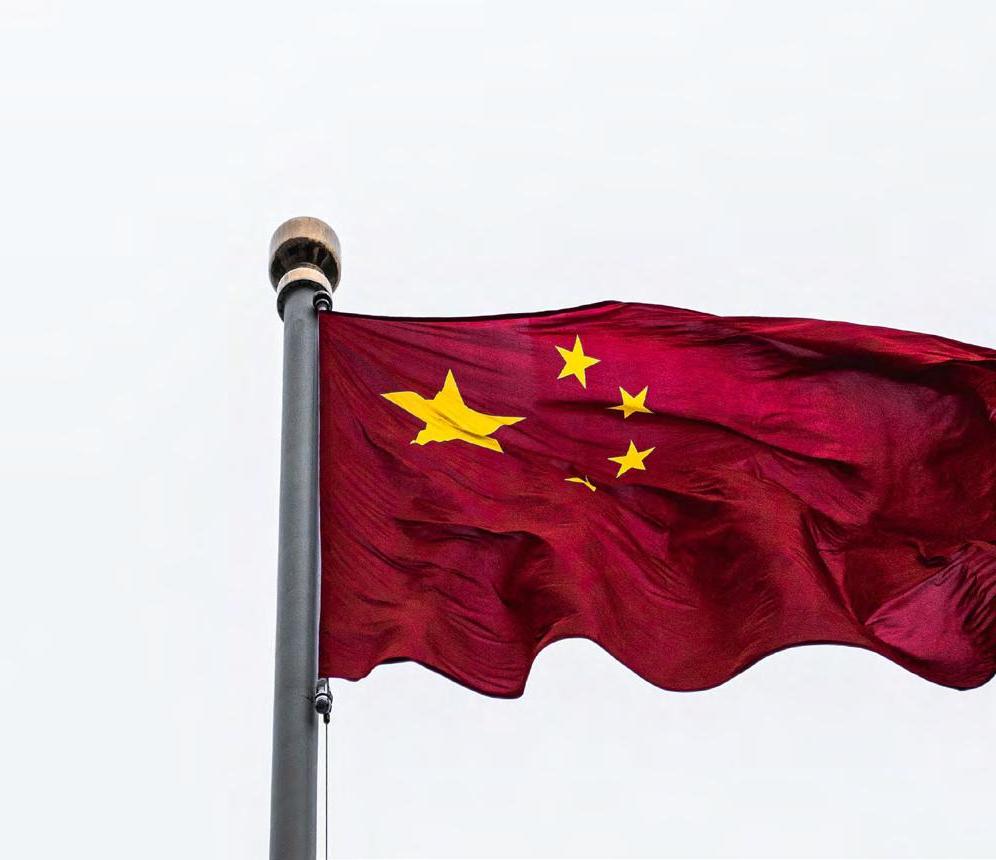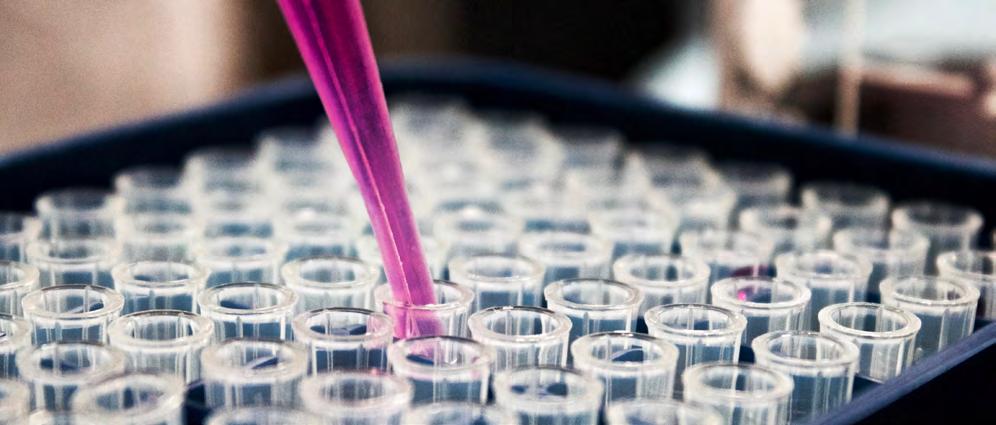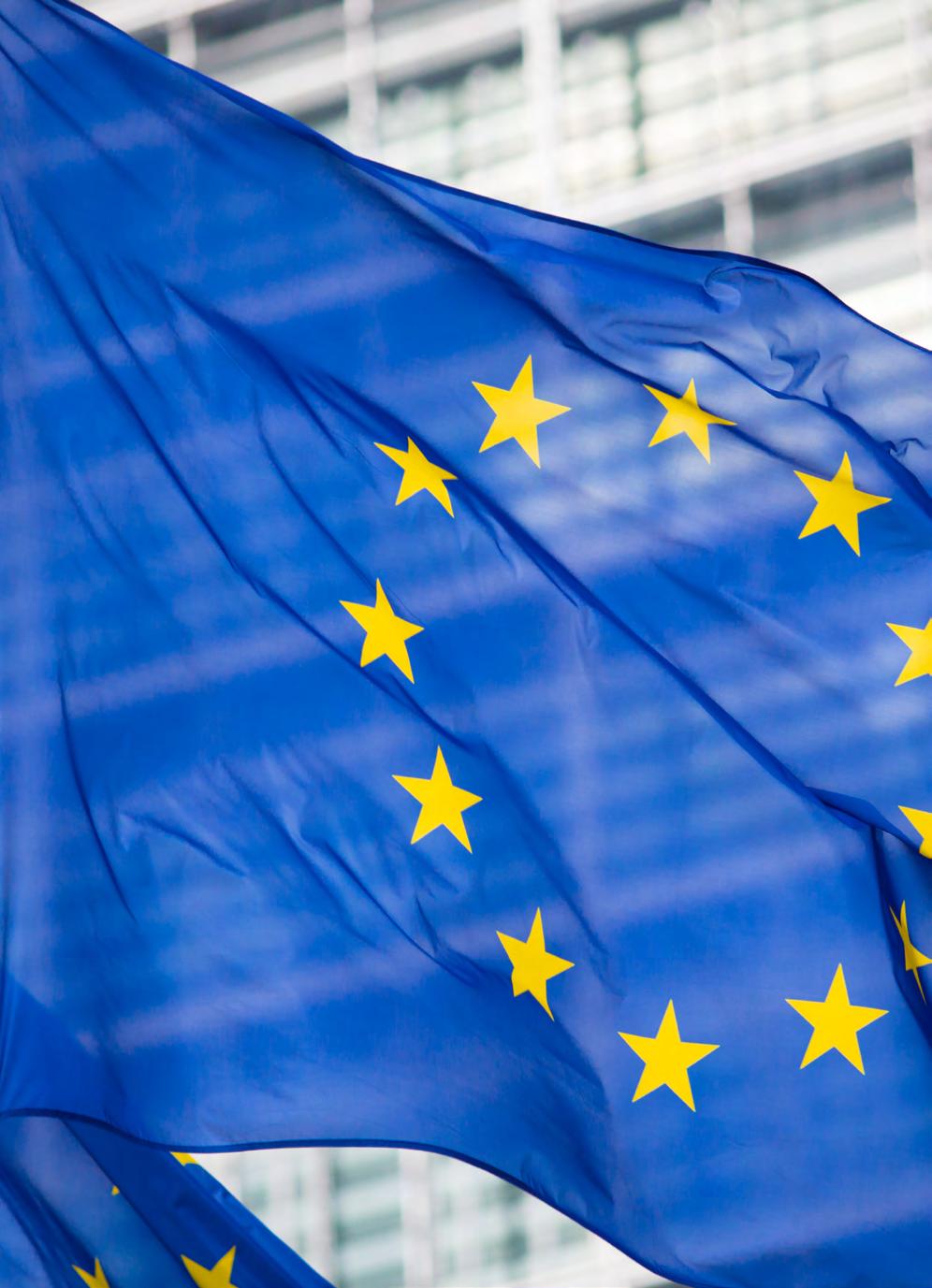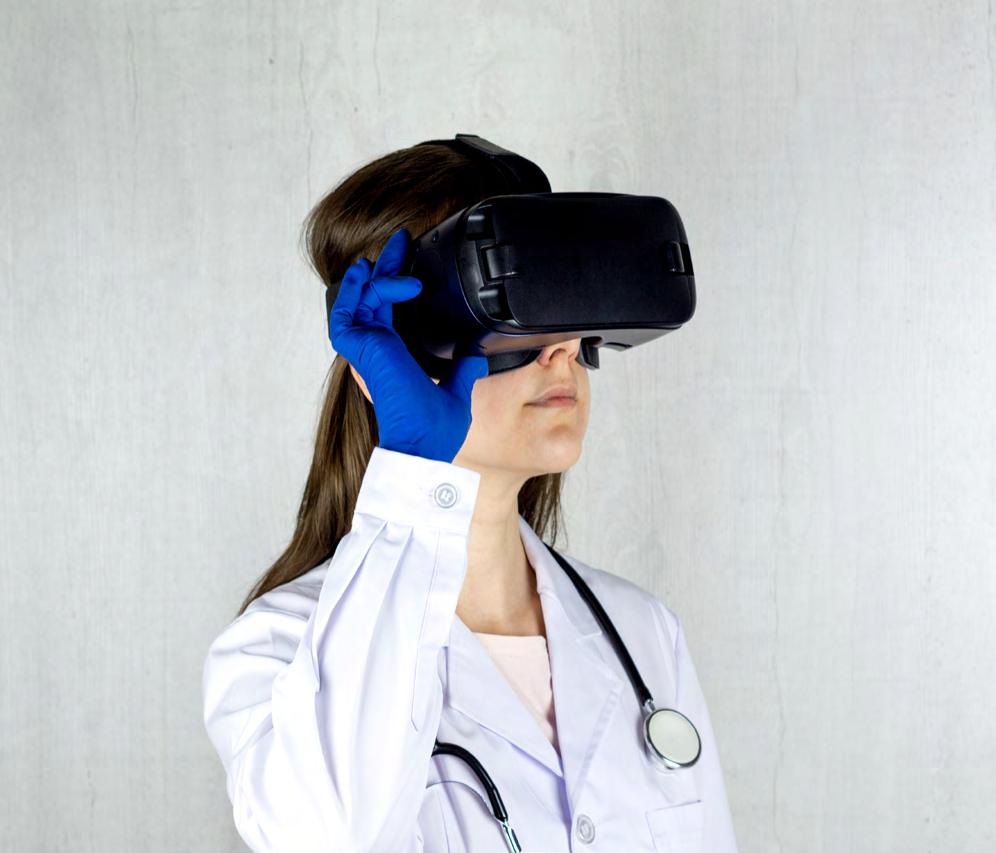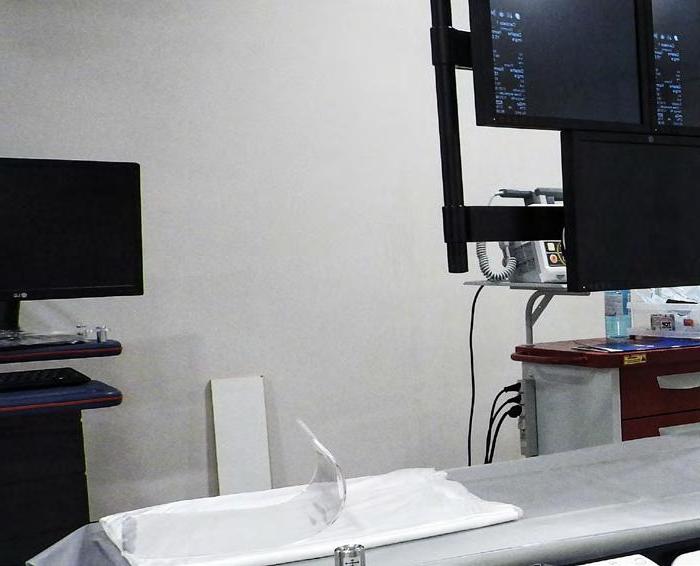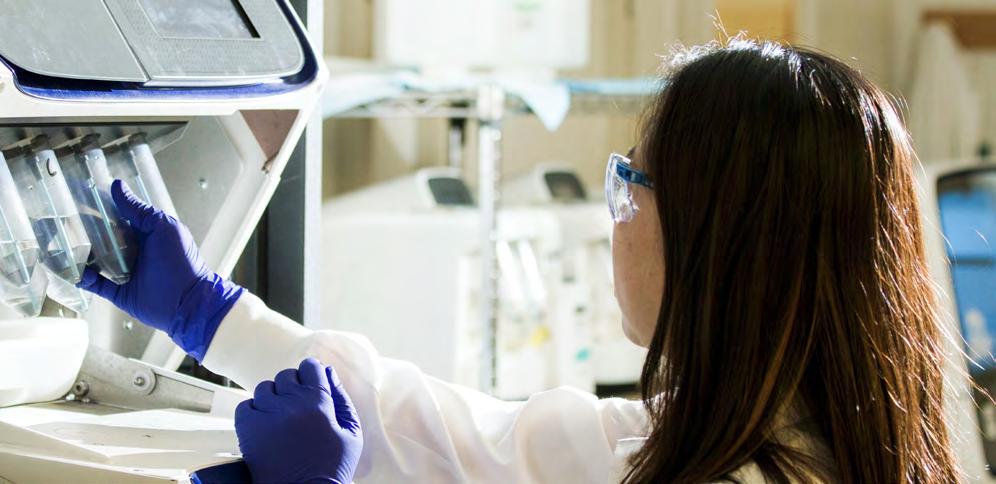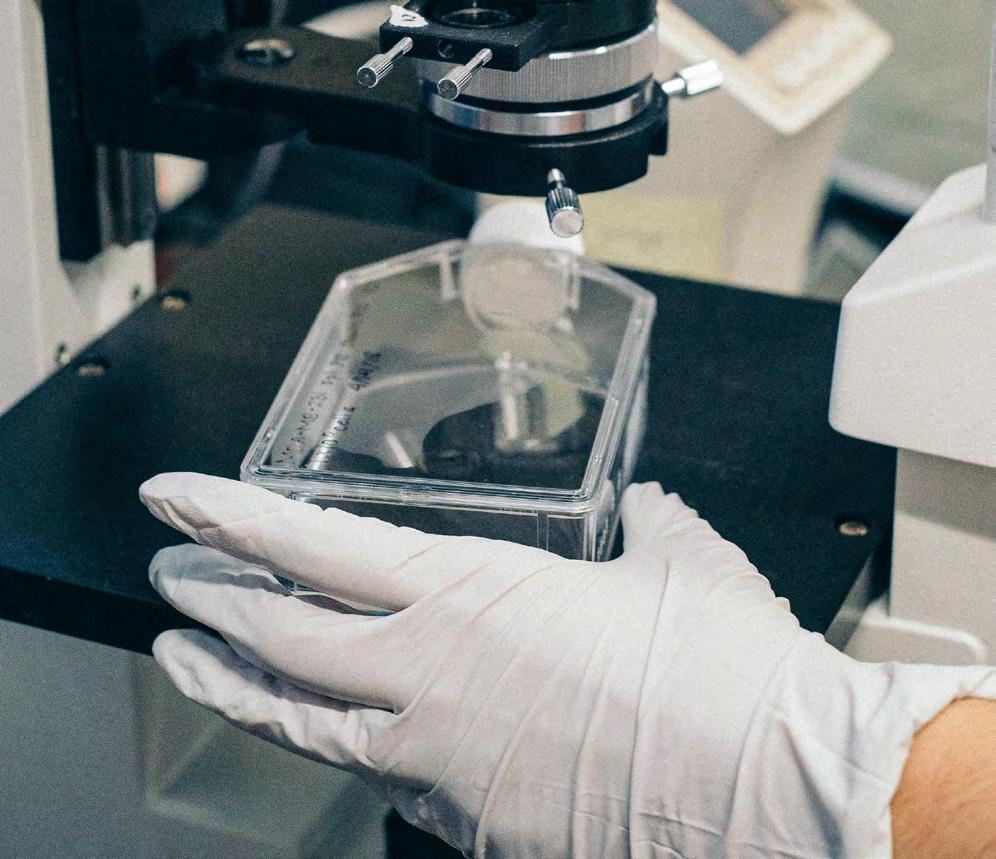
29 minute read
05 Advance global health
05
Advance global health
Multilateralism Pandemic Response Digitalization
The 2030 Agenda for Sustainable Development was adopted by all United Nations member states in 2015. Its health-related Sustainable Development Goals (SDGs) particularly SDG 3 aim to “ensure healthy lives and promote well-being for all” 73 . National and EU efforts to implement “health in all policies” therefore naturally contribute to the global sustainability agenda. Bilateral cooperation can complement and support the global agenda. It enables the countries to not only support one another’s policies and improve health for the EU and China (whose populations combined account for about 1.8 billion people - one quarter of the world’s population), but also act in alliance to drive minilateralism, plurilateralism, and multilateralism. The World Health Organization’s commitments and activities, and its agenda-setting in the G20, are therefore key to achieving advances in areas such as the strengthening of health
73
United Nations, Goal 3: Ensure healthy lives and promote well-being for all at all ages, <https://www.un.org/sustainabledevelopment/health/> (accessed on 17.07.2020). systems. These formats provide the right combination of health system expertise and financing. And they involve issues such as securing free trade, resilient international supply chains, and the promotion of innovation and science. In the same line of thought, promoting and facilitating formats such as Business20 and Science20 74 is also key to strengthening valuable global networks and thinking as important contributors of expert knowledge. Furthermore, the WTO is also an important forum thanks to its customs liberalization and trade facilitation capacities and agreements. At the multinational level too, ”health in all policies” should therefore be an obligatory requirement that is viewed as essential.
Germany, the EU, and China have all signaled willingness to assume global responsibility for strengthening
74
G20, Improving Global Health – Strategies and Tools to Combat Communicable And Non-Communicable Diseases, <https://royalsociety.org/-/media/aboutus/international/g-science-statements/2017-improving-global-health. PDF?la=en-GB&hash=BC6B2343D6133377920849DCDACED01E>.
health systems. They also have emphasized the importance of multilateralism in joint efforts to improve health around the globe. This was reinforced by statements by German Chancellor Angela Merkel 75 , European Commission President Ursula von der Leyen 76 , and Chinese President Xi Jinping at the virtual 73rd World Health Assembly on May 18th. In the mission letters to the commissioners, European Commission President Ursula von der Leyen calls on every commissioner to contribute to the overarching goal of achieving the UN SDGs 77 . This is a much-appreciated sign. Considering the size of the Chinese and EU populations, their economic strength, and their penetration into global supply chains, they would be well positioned to jointly advance global health efforts.
The challenges
The list of global health challenges is long and growing. Two goals in particular have dominated the multilateral agenda over the last two years: 1) achieving universal health coverage and strengthening health systems (and since late 2019 and early 2020,) handling the response to the SARS-CoV-2 pandemic. German industry is calling for further advances of these global health goals and for including them in bilateral cooperation. In addition, the health care industry is ready to support these endeavors through collaborations and public-private partnerships with stakeholders from science, civil society, and the public sector 78 .
75
76
77
78
World Health Organization, 73rd World Health Assembly – Speeches and News Releases, <https://www.who.int/about/governance/world-health-assembly/ seventy-third-world-health-assembly/speeches-and-news-releases> (accessed on 17.07.2020).
European Commission, Speech by President von der Leyen at the World Health Organization's 73rd Assembly, <https://ec.europa.eu/commission/presscorner/ detail/en/SPEECH_20_916> (accessed on 17.07.2020).
European Commission, Mission letter to Stella Kyriakides Commissionerdesignate for Health, 10.09.2019, p. 2, <https://ec.europa.eu/commission/ sites/beta-political/files/mission-letter-stella-kyriakides_en.pdf>. For example: Innovative Medicines Initiative: https://www.imi.europa.eu/newsevents/press-releases/imi-announces-covid-projects-boosts-funding-poteur-72-million; Accelerator: World Health Organization, Access to COVID-19 Tools (ACT) Accelerator, <https://www.who.int/publications/m/item/accessto-covid-19-tools-(act)-accelerator>; Action fund on Anti-Microbial Resistance: <https://www.ifpma.org/partners-2/the-amr-action-fund/> (all accessed on 17.07.2020).
1. Strengthening health systems and Universal Health Coverage
The G20 and the UN have become important actors for global health. Since 2015, the G20 member states have begun to advocate for concrete global health action and strengthening health systems. In addition, the United Nations’ General Assembly devoted the 2019 UN HighLevel Meeting to UN SDG goal 3.8: Universal Health Coverage (UHC) 79 . In the run-up to the UN HLM on UHC, governments and non-governmental stakeholders (including industry) coordinated efforts to advance the UHC policy agenda, e.g., through an interactive multi-stakeholder hearing convened by the President of the General Assembly 80 . At least half of the world’s population still lacks access to essential health services, and almost 100 million people a year are pushed into extreme poverty by the costs of essential health care 81 , consequently this is an important joint action. The aim of UHC is to ensure that all individuals and communities have access to high-quality essential health services without risk of financial hardship. Both Germany and China have contributed to UHC, either by promoting multilateralism or by advancing their respective domestic health policies in particular.
The German government has demonstrated its commitment to global health and UHC through a number of initiatives and institution-building decisions, such as, by placing the establishment of effective health systems on the agenda for the G8 and by establishing the Science 20 Dialogue Forum on Improving Global Health during Germany’s G20 presidency in 2017 82 .
79
80
81
82
United Nations, Political Declaration of the High-level Meeting on Universal Health Coverage “Universal Health Coverage: Moving Together to Build a Healthier World, 23.09.2019, <https://www.un.org/pga/73/wp-content/uploads/ sites/53/2019/05/UHC-Political-Declaration-zero-draft.pdf>.
https://www.uhc2030.org/news-events/uhc2030-events/multi-stakeholderhearing-in-preparation-for-the-united-nations-general-assembly-high-levelmeeting-on-uhc-542996/ UHC2030, Multi-stakeholder hearing in preparation for the United Nations General Assembly high-level meeting on UHC, <https:// www.uhc2030.org/blog-news-events/uhc2030-events/multi-stakeholder-hearingin-preparation-for-the-united-nations-general-assembly-high-level-meeting-onuhc-542996/> (accessed on 17.07.2020).
World Health Organization, Half the world lacks access to essential health services, 100 million still pushed into extreme poverty because of health expenses, <https://www.who.int/news-room/detail/13-12-2017-world-bank-and-whohalf-the-world-lacks-access-to-essential-health-services-100-million-stillpushed-into-extreme-poverty-because-of-health-expenses> (accessed on 17.07.2020).
G20, Improving Global Health – Strategies and Tools to Combat Communicable And Non-Communicable Diseases, <https://royalsociety.org/-/media/about-us/ international/g-science-statements/2017-improving-global-health.PDF?la=en-GB &hash=BC6B2343D6133377920849DCDACED01E>.
Beyond agenda-setting, the German government—the fourth largest contributor to the WHO 83 —has provided and advocated for adequate funding of global health initiatives in multilateral organizations. The German government has also triggered an inclusive policy process with non-state actors to prepare the governments’ new global health strategy, and it has set up a parliamentary sub-committee 84 dedicated solely to global health (the Subcommittee on Global Health of the German Bundestag). Looking to the second half of 2020, Germany’s presidency of the European Council is expected to add another layer to its efforts to promote multilateralism in the strengthening of global health systems.
China, in turn, has integrated global health and UHC goals into a very ambitious national health strategy. Its wide-ranging health policy reforms under the Healthy China 2030 initiative also aim to achieve UHC by working to improve health care services and health insurance coverage countrywide 85 . At a plurilateral and multilateral level, China has repeatedly called for efforts to strengthen multilateral efforts aimed at improving global health, most recently in President Xi’s speech at the 73rd WHA. President Xi called for a global response to COVID-19, proposed global reserves of medical supplies, and announced financial support for developing countries 86 . His call for multilateralism was followed by a white paper titled “Fighting Covid19: China in Action” 87 . The white paper elaborated comprehensively on China’s fight against the epidemic, but also further outlined the steps to build a successful global community capable of providing health for all. In concrete terms, the white paper stresses the value of international solidarity and cooperation, calling on the international community to recognize WHO’s leading role in pandemic response and to adequately fund the organization. The white paper also emphasizes the importance
83
84
85
86
87
World Health Organization, Assessed contributions overview for all Member States As at 31st December2019, 31.12.2019, p. 3, <https://www.who.int/ about/finances-accountability/funding/AC_Status_Report_2019.pdf?ua=1>. Bundestag, Unterausschuss Globale Gesundheit, <https://www.bundestag. de/globale_gesundheit> (accessed on 17.07.2020). Tan, Xiaodong et al., Global commitments and China’s endeavors to promote health and achieve sustainable development goals, Journal of health, population, and nutrition vol. 37,1 8, 12.04.2018, <https://www.ncbi.nlm.nih.gov/pmc/ articles/PMC5898031/>.
Globaltimes, Full text: Speech by President Xi Jinping at opening of 73rd World Health Assembly, <https://www.globaltimes.cn/content/1188716.shtml> (accessed on 17.07.2020).
China State Council Information Office, Fighting Covid-19 – China in Action, <http://www.xinhuanet.com/english/2020-06/07/c_139120424.htm> (accessed 17.07.2020). of multilateral organizations including the G20, APEC, and BRICS, reiterates the G20 consensus reached at the Extraordinary Leaders’ Summit on COVID-19, calls on the IMF and World Bank to provide emergency aid to African countries, and appeals to the WTO to safeguard the multilateral trading system and secure international supply chains. Finally, it emphasizes that the global community needs to work together to stabilize and rehabilitate the world economy and mitigate recession. China expressly warns that decoupling and deglobalization may divide the world 88 . The WTO shall therefore have all support to cut tariffs, remove barriers, facilitate flow of trade, and keep international supply chains secure and smoothly functioning.
Finally, the EU has played an increasingly major role in UHC, e.g., through its Beating Cancer Plan, despite the EU having limited health care responsibilities or competencies from the treaties. With new ideas promoting new EU competencies in health, for example during the Merkel-Macron summit on May 18, 2020 89 , and with the new EU4Health program, the EU may play an even more dynamic role in strengthening health systems in the future. Looking forward, industry is encouraging governments to push issues including digital health, better patient access to innovative diagnostics, treatments and medicines able to support better access to care in rural areas, and monitoring and treatment of elderly patients with chronic diseases. A more detailed position on UHC is included in the German Health Alliance Position Paper on Global Health 90 .
2. Pandemic preparedness and pandemic response
By definition, a pandemic is the worldwide spread of a new disease 91 . Effective pandemic prevention, preparedness, and mitigation policies therefore need to be planned and coordinated internationally. Implementing the International Health Regulations, collaboration between WHO member states, and coordination
88
89
90
91
Ibid.
Bundeskanzlerin, Emerging stronger from the crisis, <https://www. bundeskanzlerin.de/bkin-en/news/dt-franz-initiative-1753890> (accessed on 17.07.2020).
German Health Alliance, Globale Gesundheit: Eckpunkte der Wirtschaft für die Strategie der Bundesregierung, <https://gha.health/wp-content/uploads/ Globale-Gesundheit_Eckpunkte-der-Wirtschaft.pdf>.
World Health Organization, What is a pandemic?, <https://www.who.int/csr/ disease/swineflu/frequently_asked_questions/pandemic/en/> (accessed on 17.07.2020).
of actions by the WHO are therefore vitally important. The G20 can act as an additional forum for agenda setting, provide political support and financing for coordinating pandemic responses, and address trade and financial issues such as customs measures and development aid. The current COVID-19 crisis has shown how quickly and severely international supply chains, national economies, and state budgets can be impacted when national governments fail to initiate necessary pandemic responses. During the current crisis, the 73rd WHA and Chinese President Xi in particular recognized vaccines against COVID-19 as a global public good 92 , and industry has acknowledged the unique situation created by the pandemic 93 . However, some stakeholders have even gone so far as to question the intellectual property rights (IPR) system as a whole. It should be noted that strong IPR is a key foundation for availability of treatment options against COVID-19 that are currently being studied and for development of candidate vaccines against COVID-19. IPR has been a driver in the fight against the current pandemic, not a barrier to it.
The BDI and GHA have identified an initial first set of necessary adjustments and actions that should be addressed by the G20 and WHO. Naturally, those adjustments cannot yet be viewed as the last word in terms of lessons to be learned, since at the time of writing the world is still in the midst of the pandemic. Instead, a constant analysis of prevention and reaction measures and their effects should be undertaken, and further actions performed as necessary.
3. Maintain supply chains and the flow of goods
Trade barriers
Trade barriers can significantly impede national and international efforts to mitigate a pandemic, because they may prevent much needed supplies from getting to where they are most needed. In the early stages of COVID-19, a number of countries had imposed export restrictions, most notably on personal protection equipment (PPE) for personnel and active pharmaceutical
92
93
Globaltimes, Full text: Speech by President Xi Jinping at opening of 73rd World Health Assembly, <https://www.globaltimes.cn/content/1188716.shtml> (accessed on 17.07.2020).
International Federation of Pharmaceutical Manufacturers & Associations, Joint Statement – Innovative Health Industries @WHA 73, <https://www.ifpma.org/ resource-centre/joint-statement-innovative-health-industries-wha73/>. ingredients (APIs). This made it challenging to avoid disruptions to production of medicines and medicinal products, which in turn affected diagnosis and treatment of patients. PPE is essential for maintaining hygiene standards in medical production facilities and laboratories. At a multilateral level, a number of countries are now aiming for better crisis-preparedness by identifying emergency health care products and services prior to a pandemic. To that end, industry requires that these products should be subject to multilateral agreements that stipulate no ad hoc hoarding, as well as protection from export restrictions. President Xi’s proposal at the 2020 World Health Assembly to establish a global stockpile of essential medical products 94 can be considered a strong signal for greater solidarity and for a more coordinated global approach to humanitarian aid preparedness. There is, however, a need to thoroughly discuss stockpiling modalities with all relevant partners, including industry experts. Sudden and purely national stockpiling solutions could even be counterproductive and endanger patient access. To that end, industry experts’ views on issues including product supply and supply chain management need to be taken into account, in order to prevent unintended trade divergencies or disruption in of trade in goods, to make good on supply commitments, and thus not cause supply difficulties that might impact patients. In the EU and around the world, there is much discussion at the public and government levels about overdependence on single countries for strategic goods and reshoring of production facilities and warehousing. A holistic analysis and integrated approach are required to find the right balance between competing interests in this area. The health care sector as a whole opposes an imposition of mandatory localization of industries´ production sites and supply chains. There is a need to find alternative means for achieving better pandemic prevention and creating resilient international supply chains that continue to function in the event of a crisis. When stockpiling is considered, international public stockpiling seems more favorable and workable for a number of reasons. Sudden and purely national solutions are critical to patient access and supply chain management. Initiatives such as the regional reserve of essential medical supplies by the ASEAN Plus Three are thus a welcome alternative to national
94
Globaltimes, Full text: Speech by President Xi Jinping at opening of 73rd World Health Assembly, <https://www.globaltimes.cn/content/1188716.shtml> (accessed on 17.07.2020).
solutions 95 . In all of these areas, German, EU, and Chinese government agencies are being encouraged to lay the groundwork through bilateral talks, while using the G20, WHO, and WTO to promote this idea globally. In addition, export authorizations should be introduced wherever export restrictions are still being considered so as to avoid interrupting intra-company trade.
Medical goods imports should be facilitated to ensure better patient treatment and crisis-preparedness. This can be achieved by reducing or eliminating tariffs on medical goods. Industry therefore welcomes Phil Hogan’s signal that the European Commission, in collaboration with the WTO, is willing to not only temporarily liberalize tariffs on medical goods during the pandemic, but also to advocate for a respective multilateral agreement to eliminate duties on global medical trade 96 . From an industry perspective, a multilateral agreement between all WTO member states would be the preferred option. The next best option would be an extension of the scope and membership of the zerofor-zero agreement. For both options, China can be an important ally, as it most recently repeated its call for the removal of trade barriers in its white paper on fighting COVID-19. Countries that envision creating strategic stockpiles of medicinal products at the national or international levels should take advantage of industries’ capabilities and expertise in international supply chains. Emergency plans drawn up unilaterally by governments may fail to reflect actual industrial capacity. To avoid this scenario, industry needs to be involved in designing any such plans.
Border controls
By shutting down domestic and international borders as part of their COVID-19 responses, governments have imposed severe constraints on global supply chains. Stricter border controls have meant that road transport in particular has been backed up, with traffic jams several kilometers long, or even denied entry 97 —even
95
96
97
Association of Southeast Asian Nations, Joint Statement of the Special ASEAN Plus Three Summit on Coronavirus Disease 2019 (COVID-19), <https://asean. org/joint-statement-special-asean-plus-three-summit-coronavirus-disease2019-covid-19/> (accessed on 17.07.2020).
European Commission, Coronavirus: European Commission backs international initiative to facilitate trade in healthcare products, <https://ec.europa.eu/ commission/presscorner/detail/en/ip_20_1042> (accessed on 17.07.2020).
“Traffic chaos at German-Polish border a threat to local supply chains?”, in Deutsche Welle, 19.03.2020, <https://www.dw.com/en/traffic-chaosat-german-polish-border-a-threat-to-local-supply-chains/a-52834298> (accessed on 17.07.2020). within the Schengen Area. While air and sea freight was allowed to continue in China, there was significant disruption to imports of medical goods by road and rail. Some companies have stated this was due to additional controls conducted at a small number of major entry points at ports and airports. Open borders for goods are, however, imperative for maintaining the flow of essential goods, especially during a crisis. Governments have understandably wished to impose stricter controls on the movement of people coming into the country. As an unintended consequence, at some borders, entry bans and measures such as temperature checks and preventive quarantining of lorry drivers have brought international trade to a complete halt. To ensure continuity of critical supply chains, government pandemic response measures would benefit from being developed in close collaboration with representatives from essential industries and their suppliers. These measures would include dedicated fast lanes for freight vehicles carrying medical equipment, API, and medical products, much like the European Union’s green lanes for ensuring the flow of essential goods during COVID-19. One early lesson to be learned from the crisis is that criteria for classifying such freight should be elaborated on and agreed upon ex ante. Any such agreements should be aimed at operations at the G20 level and potentially be inserted as an annex to the WTO Trade Facilitation Agreement— ideally elaborated on in close consultation with WHO. In addition, consideration should be given to digital testing solutions that could potentially replace current border practices.
4. Strengthen multilateralism and collaboration
World Health Organization (WHO)
A pandemic requires a coordinated multilateral response. With its global reach and expertise, WHO plays a crucial, central role in coordinating member states and collaborating with partners in industry. WHO’s role includes establishing ongoing transparency with respect to information on novel pathogens, with the aim of enabling member states to continuously update their pandemic countermeasures. In addition, WHO acts as a focal point for non-government stakeholders to facilitate and ensure transparency with respect to possible treatments, vaccines, and diagnostics. In this context, WHO works closely with organizations such as business associations and universities to facilitate the
pooling of resources and information across sectors in order to make diagnostics, therapeutics, and vaccines available. One example is the recently established Access to COVID-19 Tools Accelerator 98 , a direct result of WHO’s leadership and ability to bring together relevant organizations on a global scale. This enables industry (a founding member of this new coalition) to make valuable contributions to the development of diagnostics, therapeutics, and vaccines. Industry-specific initiatives, such as repurposing manufacturing facilities to produce disinfectant and protective equipment, planning to reserve and re-dedicate production facilities for the time when a vaccine or effective treatment is found or opening up compound libraries to speed up R&D of vaccines and treatments 99 , are also making important contributions to overall efforts to combat the pandemic. Together with necessary extra facilities, additional testing capacity, and effective isolation of newly infected individuals, these efforts will enable governments to implement alternative strategies for exiting or coping with the current arduous lockdowns. These lockdowns pose a major challenge to the achievement of other public health goals, such as meeting social and economic needs. Once a certain degree of protection for people’s health and control in providing life-saving health care treatments is ensured or regained, this rebalancing of interests will therefore make an important contribution to public health goals, mitigating the recession and safeguarding the health and prosperity of people in the future. It is important that all countries do their utmost to strengthen WHO. This requires a transparent, long-term approach and will maximize WHO’s ability to fulfil its role of initiating innovation and coordinating research.
Detect and diagnose
Before and during a pandemic, early detection and diagnosis help to trigger rapid preventive and response measures. Systems such as WHO’s Global Influenza Surveillance and Response System act as global alarm systems and are therefore critically important. This system encompasses Germany, China, and 113 other WHO member states 100 . In order to allow new pathogens to be detected as early as possible, it should be a common goal to extend this network’s coverage to all WHO member states. If evidence of a pandemic is detected, targeted and large-scale testing needs to be rapidly available and deployable. To this end, rapid development and availability of diagnostics for new infectious diseases should be a common goal and facilitated within the network. Collaboration with specific international organizations such as FIND 101 would further contribute to that goal. The ability and agility to react and combine knowledge, capabilities, and forces across borders is key to combating pandemics. Where and how a specific virus or disease will spread is by definition unpredictable. This challenge will always require expertise from the business world. In addition, the capacities and personnel needed for testing large parts of the population should be assessed, trained, and tested prior to and in the event of an outbreak, ideally with the support of public-private partnerships. In a similar vein, consideration should also be given to regulatory requirements for global use and compatibility of contact-tracing apps.
5. Deploy diagnostics, therapeutics and vaccines
Facilitate clinical trials
Overcoming a pandemic requires new treatments. Clinical trials for therapeutics and vaccines therefore need to commence quickly and be held back by a minimum of bureaucracy, while still maintaining quality and patient safety. During a pandemic, the ability to conduct ongoing and new clinical trials is impeded by measures such as social distancing and a reluctance among trial participants to visit hospitals. Governments therefore need to prepare frameworks that include digital approaches to clinical trials, such as remote monitoring. These frameworks should be extended to cover global and electronic licensing of any products that have undergone successful trials. These measures obviously require tremendous amounts of coordination. WHO’s Solidarity
98
99
World Health Organization, Access to COVID-19 Tools (ACT) Accelerator, <https://www.who.int/publications/m/item/access-to-covid-19-tools-(act)- accelerator> (accessed on 17.07.2020).
European Federation of Pharmaceutical Industries and Associations, European pharmaceutical industry response to COVID-19, <https://www.efpia.eu/ covid-19/member-updates/> (accessed on 17.07.2020). 100 World Health Organization, Global Influenza Surveillance and Response System (GISRS), <https://www.who.int/influenza/gisrs_laboratory/en/> (accessed on 17.07.2020).
Trial for COVID-19 102 treatment is a promising first step towards much needed multi-stakeholder collaboration.
Fundamental steps for overcoming a pandemic include consolidating clinical knowledge about a new pathogen and making it available to health authorities around the globe including early information and specimen sharing, virus sample labs, global platforms, and producing interim treatment guidelines. These tasks are carried out by WHO 103 .
Facilitate production and distribution
Without a treatment or vaccine, many governments have responded to the COVID-19 pandemic with non-pharmaceutical measures such as social distancing, hand washing, coughing etiquette, and mask wearing. Some of these have given rise to their own political, economic, and social challenges. A medical breakthrough is a key requirement for lifting social distancing and mask-wearing requirements. Once developed, diagnostics, treatments, and vaccines will require rapid, large-scale production and distribution networks. These networks will require multilateral, multi-industry coordination, with government financial support to enable industrial technology, facilities, and expertise. The G20 should therefore agree to provide for tax and investment facilitation when production, warehousing, and/or distribution sites are set up or existing sites are repurposed.
6. Digital health
Digital health tools can contribute to achieving universal health coverage (UHC), improving global health security, and advancing patient-centered health care. The global response to COVID-19 has also shown the potential of digital health tools as pandemic response measures. In recent weeks, for example: . Health care providers have turned to telehealth and telemedicine tools for diagnosing COVID-19 patients safely and remotely.
102 World Health Organization, “Solidarity” clinical trial for COVID-19 treatments, https://www.who.int/emergencies/diseases/novel-coronavirus-2019/globalresearch-on-novel-coronavirus-2019-ncov/solidarity-clinical-trial-for-covid19-treatments (accessed on 22.07.2020). 103 World Health Organization, Country & Technical Guidance - Coronavirus disease (COVID-19), <https://www.who.int/emergencies/diseases/novelcoronavirus-2019/technical-guidance> (accessed on 17.07.2020). Insurers and other private sector organizations have developed mobile phone apps to help patients recognize COVID-19 symptoms and learn about treatment options.
Tools such as artificial intelligence are being used to diagnose COVID-19 virus, track disease development, investigate possible treatments and vaccines, and accelerate data collection for clinical trials.
Policy makers are benefiting from epidemiological models developed using advanced data analysis, while maintaining high standards for data security and privacy.
Recent advances in digital health technologies improve patient care in terms of outcome, access, and costs. Broader use of digital health tools can benefit all stakeholders in the health care system, including patients, government, doctors, health care providers, medical goods manufacturers, and other health care stakeholders. Data analysis tools, for example, can improve tracking of patient outcomes and the value of treatments delivered. Remote diagnosis, monitoring, control, training, and maintenance have been essential tools during the current pandemic and will remain essential for building up resilience. Better tracking of patient records can reduce unnecessary health interventions, while improved use of telemedicine can reach marginalized and remote communities.
Some challenges remain regarding the adoption and better use of new digital health tools. In particular, the access to and ownership of health care data must be valued. This includes the need to safeguard patient privacy, data security, regulatory uncertainty (which can reduce the usefulness of digital platforms), and inconsistencies in approaches to digital health taken by different countries and health care stakeholders.
G20 and WHO leadership in digital health
The G20, as a forum for agenda-setting, and WHO, with its greater capacity for policy implementation, can complement each other’s efforts on digital health. At the time of writing, WHO has published its draft Global
Strategy on Digital Health 2020–2024 104 . Industry is still assessing it, but overall the comprehensive framework for governance, cooperation, and alignment of WHO stakeholders on digital health has been well received, as has the respect the draft strategy pays to regional and national circumstances. However, industry would appreciate a clearer vision for how WHO will collaborate with other multilateral organizations such as WIPO and WTO.
The BDI and GHA encourage the G20 (and in the long term potentially also WHO) to promote use of digital tools for diagnosing and treating patients. It would serve to enhance the broader health care ecosystem, remove policy barriers that hinder use and adoption of digital tools, leverage health data to improve care, and optimize use of health data in regulatory systems. This would improve patient access, achieve more equal access, better meet patient needs, improve preventive care, and enhance efficiency. Digital learning and remote education of students and professionals can also be enhanced. Specifically, the G20 can:
Recommendations on Digitalization:
Facilitate adoption of digital health tools: To facilitate adoption of digital health tools, push for regulatory consistency, also by establishing transparent and fair regulatory frameworks for use of such tools and guidance governing their use. These should include suitable adaptive measures to account for the dynamic nature of new technologies.
Include industry: Include industry in discussions on regulatory and other policy barriers that impede adoption of new health technologies.
Bring together digital technology experts: Convene regular forums to bring together digital technology experts from different sectors and industries to consider issues, emerging trends, and policy recommendations.
Ensure interoperability: Ensure cross-border interoperability throughout health care systems.
104 World Health Organization, Draft global strategy on digital health 2020–2024, 22.03.2020, <https://www.who.int/docs/default-source/documents/ gs4dhdaa2a9f352b0445bafbc79ca799dce4d.pdf?sfvrsn=f112ede5_42>. Establish appropriate data security: Establish appropriate data security and privacy policies that safeguard digital information, without preventing the cross-border flow and use of health data for the purpose of research and development and innovation.
Support research and innovation: Support continuous access to scientific discoveries and facilitate appropriate access to national health data sets to support research and innovation.
Develop joint language: Develop a common lexicon to facilitate further adoption of digital R&D tools and technologies or start to develop one before the next G20 summit.
Promote the value of digital health solutions:
Advocate to adopt reimbursement systems to appropriately fund new digital health tools, such as payments for telemedicine and digital therapeutics.
Encourage new technologies, R&D, and collab
oration: Promote an innovation ecosystem that encourages new technologies, R&D, and collaboration in the digital health sector, including innovations related to deployment and operationalization of products and services.
Engage with business: Create a mechanism for engaging with business to enhance pandemic preparedness and leverage national information centers for disease surveillance, diagnostics, virtual hospitals, and digital therapeutics.
7. Health development cooperation
Achieving UHC requires a collective effort, especially in developing countries in Southeast Asia, Central Asia, the Middle East, Africa, and South America. Improved efforts for strengthening health systems should be considered a joint undertaking on the African continent, which has some of the fastest growing economies but also the poorest countries and fast-growing populations. This applies especially to the EU and China 105 , the biggest lenders to African governments. Thereby, it
105 Brookings, Competing in Africa: China, the European Union and the United States, <https://www.brookings.edu/blog/africa-in-focus/2018/04/16/competingin-africa-china-the-european-union-and-the-united-states/> (accessed on 17.07.2020).
is important to consider that access to health care not only serves to better meet the basic health needs of individuals, it also makes an important contribution to the economy. Health centers and hospitals provide sustainable jobs for highly skilled people. Because large numbers of women are employed in health care, especially in care delivery roles, efforts to strengthen health systems also boost gender equality 106 . In African countries, where there is a large divide between larger cities and more remote areas, digital and telemedicine solutions offer an opportunity to deliver health care to everyone.
The EU, Germany, and China all have a strong presence across continental Africa. President von der Leyen has recently vowed to boost Europe’s geopolitical role, including with regard to strengthening health systems around the globe 107 . China and the EU therefore have a particular responsibility to support African governments in their efforts to modernize their health infrastructures and create health systems that guarantee universal access to health care. It is also their responsibility to convince governments that investing in measures to strengthen health systems contributes to economic strength. This can only be achieved if the EU and China are in alignment with international organizations such as WHO. In that regard, the G20’s Debt Service Suspension Initiative 108 was a clear signal for joint action in development cooperation. Furthermore, China only recently stressed its commitment to strengthening development cooperation, particularly with Africa. Particularly in the Chinese government’s white paper on COVID-19 109 , China calls on multilateral organizations including the UN, WHO, the IMF, and the World Bank to provide emergency aid to African countries. It also calls on developed countries to take on greater responsibility, play a bigger role in the global battle, and provide more material, technological, and personnel support to their developing counterparts, especially in Africa. A further important requirement
106 World Health Organization, Gender equity in the health workforce: Analysis of 104 countries, 03.2019., <https://apps.who.int/iris/bitstream/handle/10665/311314/
WHO-HIS-HWF-Gender-WP1-2019.1-eng.pdf?ua=1>.
107
“Into Africa: Von der Leyens visit kicks off “geopolitical Commission”, in Politico, 12.07.2019, <https://www.politico.eu/article/into-africa-von-der-leyen-visitkicks-off-geopolitical-commission/> (accessed on 17.07.2020). 108 G20, Communiqué - G20 Finance Ministers and Central Bank Governors Meeting 15 April 2020 [Virtual], 15.04.2020, p.1, <https://g20.org/en/media/Documents/
G20_FMCBG_Communiqu%C3%A9_EN%20(2).pdf>. 109 China State Council Information Office, Fighting Covid-19 – China in Action, <http://www.xinhuanet.com/english/2020-06/07/c_139120424.htm> (accessed 17.07.2020). is a shared understanding of sustainable development aid and international cooperation.
The EU, Germany, and China should therefore also use their influence in collaboration with the G20 to strongly support the aforementioned initiatives for health, trade, financial matters, and initiatives for peace, to help end intra-African conflicts that lead to high levels of migration and erode health care provision. Achieving SDG3 will require access to health care, good health literacy in all communities, ongoing training to improve skills of medical staff, modern health infrastructure, and access to innovative diagnostics and treatments. This applies particularly to the African continent. The EU and China can strengthen Africa’s health care systems. However, it is important that this be done on a level playing field for all stakeholders. The EU and China share the need to strengthen health care systems in their partner countries and regions, and to collaborate through the WHO and through trilateral EU-China-African partnerships where appropriate and useful.
Recommendations for the overall multilateral agenda:
Strengthen multilateralism: To achieve the health-related goals of the UN SDGs, national and multilateral efforts need to complement each other. Germany, the EU, and China should assume a leading role by jointly advocating for these goals in WHO, the G20, and WTO. The Global Action Plan for Healthy Lives and Wellbeing strengthens collaboration among multilateral health organizations to accelerate progress on the health-related SDGs at the country level. Progress should be reported on and critically discussed at established global health forums like the World Health Summit in Berlin.
Support and enable WHO: WHO is key to advancing all health-related global goals such as UHC and pandemic prevention and response. German and Chinese efforts should work towards positioning and strengthening WHO as the central actor that requires sustainable funding and transparent collaboration. In addition to coordinated government action, cooperation in public private partnerships can be promoted where appropriate and information exchange with equal benefits for all relevant actors is ensured.
Enhance health-related action within the G20: The G20 are key to advancing a coordinated pandemic response, particularly with respect to all trade barriers that affect the resilience of international supply chains. These include tariffs, export restrictions, and invasive border controls. Also, the competence mix provided by ministers of health and finance will be key to advancing important health budget questions and possible action on customs elimination for medicinal goods. Among the urgently needed actions in the run up to the Saudi Arabian G20 presidency, G20 members should call for a worldwide stop to proliferating export restrictions. They should also move to quickly eliminate all customs duties on medical equipment, diagnostics, and medicines.
Promote Digital health: Digital health tools have particular relevance to global goals for improving health equity, achieving universal health coverage (UHC), improving global health security, and advancing patient-centered health care. They can improve patient care in terms of outcome, access, and costs. Moreover, the COVID-19 pandemic has revealed that digital health measures can replace and improve existing pandemic response measures. Germany and China should promote these benefits and work to promote investment in digital health globally and enable a regulatory framework that facilitates use of these measures during emergency and non-emergency situations.
Advance cooperation—international and intersectoral—in other global health topics, including development cooperation, e.g., with Africa. Here, a common understanding on the grounds of sustainable development aid, a needs assessment, and leveled international cooperation are essential before fruitful collaboration can take place. Since improvement of public health is always an interdisciplinary task, cooperation should be across sectors and include science, civil society, politics, and the private sector.

